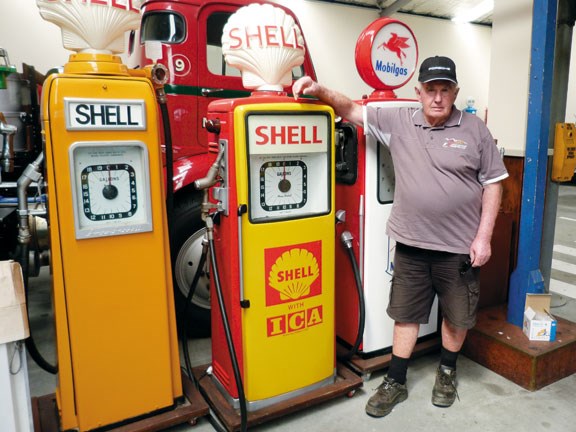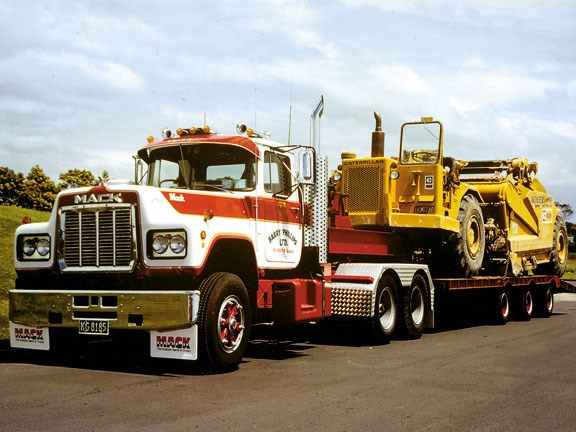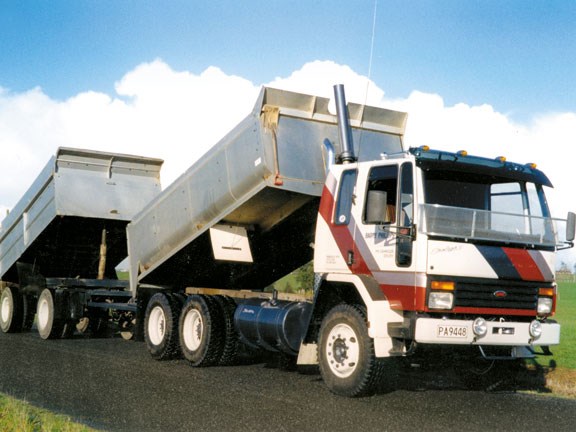Profile: Barry Phillips









|

|

|

|
Having spent a lifetime of hanging around trucks and machinery, I wasn’t going to turn down DOW Editor Randolph’s suggestion of heading out to Drury to talk trucks with the iconic Barry Phillips.

|
|
Profile: Barry Phillips
|
Barry served his time as an apprentice mechanic for Lees Bros Ford in the early 1950s, at a time when the ubiquitous Mk 1 Zephyr was at the head of every young man's wish-list and Elvis Presley was just another new name on the 'Hit Parade.'
Transportation, trucks, and the like are an integral part of the Phillips bloodline, dating back to the beginning of the twentieth century when Barry's grandfather (on his mother's side) operated a horse-drawn bus service between Cheltenham Beach and Narrow Neck on Auckland's North Shore.
His father, Alan Phillips, started his career in the transport business in the horse-and-cart era, carting goods from the Onehunga wharf to Manurewa. He called this business Manurewa Transport.
By the 1930s Alan had upgraded his operation to petrol-powered trucks, firstly with Reos and later with Diamond Ts. By the 1950s, Commers were his choice of truck.
Barry recalls driving one of his father's Commers out to Piha (a very long way from Manurewa even on 21st century roads) with a load of sealing chip and having lost all his brakes by the time he'd reached the bottom of the hill.
(Writer's note: Brake fade was a common phenomenon with many trucks. It was always a bit of a joke in the transport industry of the day, that Commers and their General Motors counterpart, the Bedford, didn't have the best of brakes.)
Alan Phillips only ever bought one brand new truck and that was a petrol-engined Commer, previously he'd preferred to buy second-hand rigs and refurbish them to his own high standards.
The new truck he bought was put into service as an articulated tanker which was the first unit of its type in New Zealand. It was used to transport ice cream mix from a factory in Manurewa to Tip Top's plant in Greenlane.
Unfortunately, the truck is long-gone but Barry has an immaculately-restored red and green Commer TS3 painted in his father's livery to serve as a reminder of the golden days of trucking. He is also in the process of restoring a Diamond T, just like the one his dad operated in 1937.
On the day I visited Barry's private museum, just to prove the Commer's TS3 (Tilling-Stevens) engine still runs, he started it up for me. It was quite a thrill to hear that hearty roar once again, a sound I hadn't heard in many a year!
But more about the museum and all that's housed within later in the story.
In the early 1960s, legendary motor racing driver Paul Fahey was Barry's neighbour. The two men, along with Ralph Emson started a car dealership in Papakura. After about 12 months, Barry purchased his partner's shares in the enterprise and became a sole trader under the name of Papakura Motors Ltd.
Barry later moved and built a new yard in Takanini. That was back in the days when Great South Road was the main route south out of Auckland and the southern motorway ended in Takanini.
In 1976 he purchased land on Great South Road in Drury and set about building the structure that the current operation runs out of today.
While I've always been interested in cars and trucks, I've only ever had a passing interest in motorsport, so I have to admit I felt a little embarrassed that I never knew it is the same Barry Phillips who is so well-known in the trucking and truck spare parts industry, that made a name for himself racing Lotus Cortinas in the mid-to-late 1960s.Somehow I'd simply never made the connection.
Prior to Lotus Cortinas, Phillips had enjoyed success on the racetrack with a 105E Anglia which was owned and serviced by his own company, Papakura Motors Ltd.
Later in the decade he went on to race Minis, winning the New Zealand Championships. At the time of writing this article, his Cortina was on display at Hampton Downs Raceway.
Barry Phillips is a man who has no interest in 'blowing his own trumpet' to the point where he avoids talking about his vast achievements, so it took some time getting to understand how one person could keep on top of being at the helm of a business that has as many layers as the Barry Phillips enterprise.
At one point in time he was running an operation that was selling complete truck and trailer units, wrecking trucks, and selling spare parts at the same time as operating a contracting business that involved several trucks, bulldozers, and traxcavators.
At the height of his last venture into the transport business, he owned and operated twenty-two trucks.
In 1986 Barry imported three Ford Cargo trucks, initially for use in his own small cartage business. He said he could never understand why Ford, in New Zealand, didn't carry on with them when the D- Series finished.
At this same time Barry formed a partnership with Archie Pollock and together they imported many used trucks from the UK, including such marques as Mercedes, Foden, ERF, Scania, and Leyland-Scammell to name a few. Ninety-five percent of these trucks were then rebuilt, with the majority of these having chassis extensions and tandem rear drives fitted to them. This company, known as Truck Imports (NZ) Ltd later went on to secure the agency and distribution rights for Seddon Atkinson in New Zealand.
This saw the return of the Seddon Atkinson brand back to New Zealand with its 'new' T3 Models in 1988.
Truck Imports held the agency here until 1993 when Iveco bought Seddon Atkinson in the UK and re-branded the truck.
Barry Phillips Motors continued to import Ford Cargos and eventually imported some two hundred units over a six-year period.Most of these trucks were powered by L10 Cummins engines, rated at either 250 or 290hp, and made perfect lightweight six-wheeler tippers of the day.
The company still carries a large inventory of Ford Cargo spare parts in 2013, though the sale of these parts would make up less than 0.1% of their total parts sales today.
Re-building, (from the ground up), over 200 Ford Cargo trucks, meant the company needed to source a multitude of parts from all corners of the world and this is the catalyst for the move into new genuine and after-market truck spare parts sales.
Parts lines today include panel and lighting parts for most Japanese and European trucks, Euroricambi transmission and differential gearing for European and American trucks, air brake, and trailer suspension parts, along with a wide range of other parts.
All of this was being carried out at the same time as re-building projects such as the R-Series Mack (pictured) and of course, restorations which were to form a part of his extensive museum collection.
I'm sure Barry won't mind my saying that unlike trucking magazine contributors who are often fixated with times, dates, and places, he appears to hold little store for details like, in what year 'this or that' occurred. He prefers to busy himself with getting on with the job.
It's a documented fact that people like Henry Ford and Albert Einstein weren't interested in clogging up their minds with such trivia as remembering their phone numbers, etc. and it's apparent that Mr Phillips is of the same ilk.
The Barry Phillips fleet of trucks was always immaculately presented and underwent a number of changes of livery, which were often quite different from the design that preceded it. I set about finding out who came up with the various smart designs to grace the vehicles over an extended period of time but I drew a blank on this exercise. I can only assume that a touch of the Phillips modesty had come to the fore once again.
Although not wanting to entirely bow out of the cut and thrust of daily business, Barry says he's definitely going to take things a little easier in the coming years. That's if you call taking care of a twenty-eight acre rural property and refurbishing artefacts for his private museum collection "taking it easy!"
Feel free to make a comment or ask us a question about this story on the Deals On Wheels  page.
page.
For the latest reviews, subscribe to our Deals On Wheels magazine here.
Keep up to date in the industry by signing up to Deals on Wheels' free newsletter or liking us on Facebook.

.jpg)

.jpg)

.jpg)

